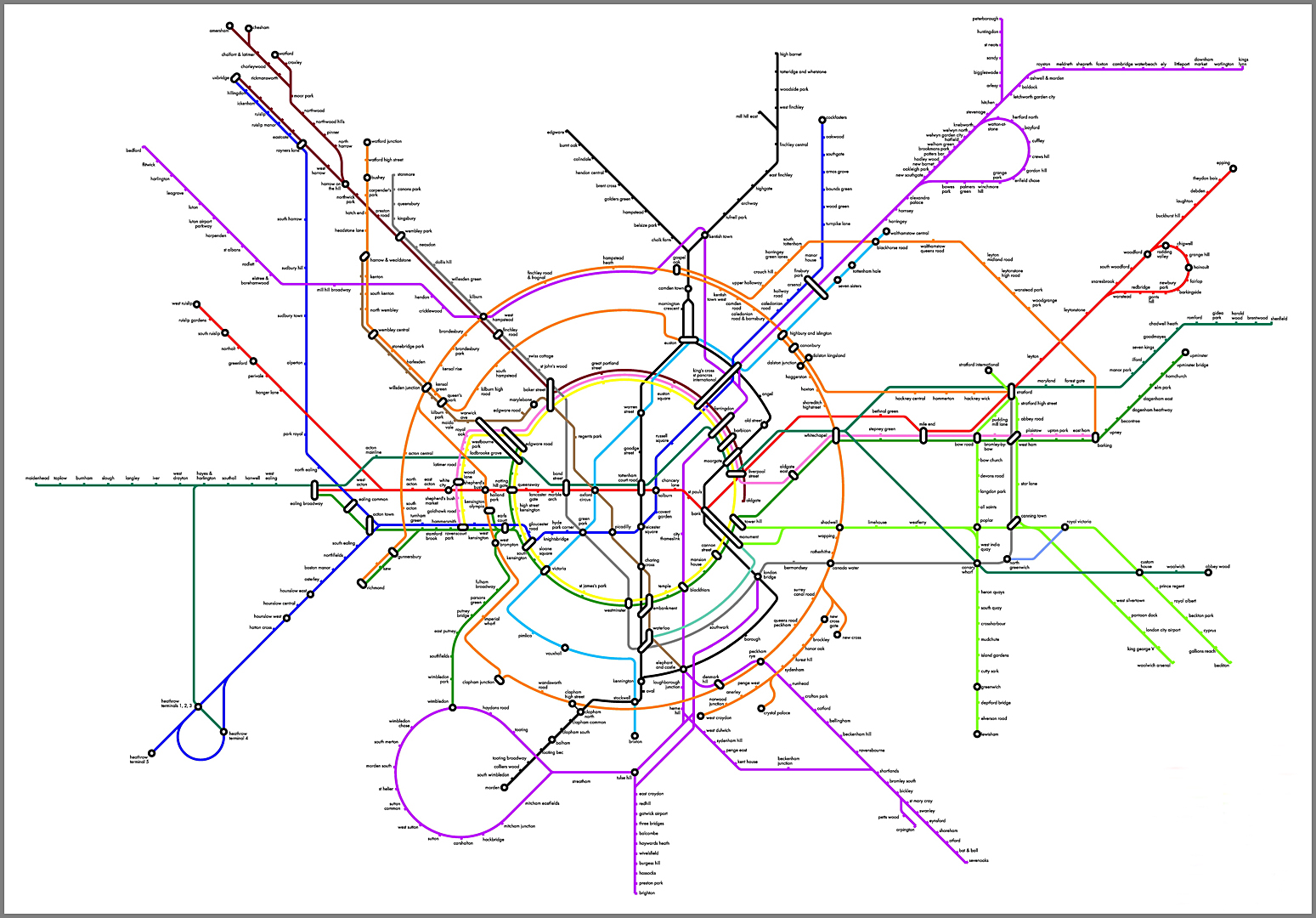Today, it is almost a shock to see the sort of striking minimalist design that was probably most associated with Massimo Vignelli in the Sixties. It is a reminder that a simple typographic system and color palette, expertly used, can hit you right between the eyes a lot more effectively than many of the graphic gymnastics we are now more familiar with. This Helvetica Hypothesis, by designer Jung Hwan shows how it works.
Category: Culture
For years now, Harry Beck’s 1931 angular London Transport tube map has been the seminal example of how to diagram transport systems. However, the system is much more complex now than when it began and designer Jonathan Fisher has responded to the resultant cartographic complication by suggesting a map based on the more conceptual idea of radial and circular lines, which is more how you tend to think of your travel in London. Interestingly, Harry beck also did some initial sketches which showed that a similar concept had also crossed his mind. Above, we compare the new suggestion with the familiar existing layout.
In 1968, our colleague and Wyman/Whitehouse partner Lance Wyman created the now-famous Mexico Olympics logotype. So memorable it has become the de facto logotype for the country in many instances. This typeform was informed by the concentric structure seen in Huichol wool thread panels and spiral Pre-Columbian stone carvings. At the TEDx conference in San Miguel de Allende this year, the theme of the conference Future Now was titled by designer Lynn Rawden in Ideoma Liner, a typeface designed by the Ideoma Communications Agency, a new typographic interpretation of this cultural reference and an exciting continuation of the theme.
This year’s TEDx in San Miguel was packed to the gills, and predominantly with young people, many of them local students. Here, Xavier Fux speaks of Urban Agriculture as a promising strategy for the new Millennium. Other contributors included Sara Hoch, who has successfully dedicated herself to the revival of the Mexican film industry, and, as Director of the Guanajuato International Film Festival, is responsible for an extensive new headquarters for GIFF here in San Miguel, construction of which will begin in January, and which will include two auditoriums and extensive film, video, and sound production and post-produchtion facilities.

The first phase of our work at the Children’s Discovery Museum of the Desert project is now completed. The aluminum shafts display the Museum’s logotype, which assembles itself visually on the pylons as you enter the site. The mural (described in the entry for 23 January, below) features 4,000 tiles to which donors portraits are continually being added, eventually aggregating into an image representing the supporting community and America’s diversity. Due to the success of the project, MGA Partners, who are the architects of this superb building, are now working on the extension of the Museum.

We recently completed this sign system for a Children’s Hospital using photo pictograms for both wayfinding and destination signs to create an accessible and children friendly environment. The system builds on our work with Lighthouse International in New York and features a tactile ledge which is easily located by sight-impaired users, and a new typeface developed by our studio to facilitate tactile reading. Both the sign system and typeface were featured in Roger Whitehouse’s keynote presentation to the International Conference on Universal Design in Kyoto in November.

Ten years ago, when we worked on the graphics with Fox & Fowle (now FXFowle) for their new Subway station in Times Square at Broadway and 42nd Street, we had the Times Square Brewery and a half-size Concorde on our shoulders. Today, we have an entire 50 storey tower and some nifty Target advertising. In fact, the graphics were recreated for the new building replicating the original design. I think that means our client may be pleased with what we came up with. We are proud to say that it appears that the Municipal Art Society were, as the signage has been honored with their blue ribbon award. More information can be seen on our project pages.

As part of the Dream Library Project, a series of mini-libraries for the New York Public School System, sponsored by McGraw-Hill and in association with Helpern Architects, we developed a series of animal forms created entirely out of typographic characters. These AlphaPets (we have about thirty to date) are designed to act as a learning stimulus for young schoolchildren. They are intended to be installed on hanging ceiling baffles and other components within the library spaces: a low-cost solution for creating a stimulating learning environment. Designers Saki Tanaka and Millie Lin in our studio were responsible for most of these and for pretending that it was hard work.


The shrines and temples of Japan abound with iconic views, in this instance a wall of Sake barrels, used as part of purification rituals, and an avenue of Torli gates, at the Shinto Hie Shrine in Tokyo.

One of the delights of being invited to conferences is meeting new colleagues and discovering their work. This was particularly the case in Kyoto in October, where among many new introductions, I met Toshimitsu Sadamura, the designer of the new Fukuoka City Subway, Nanakuma LIne. This ten-year project puts other subway systems to shame for its clarity of vision and depth of attention to detail. Spectacular in every aspect, it is its accessibility that it particularly impresses. Universal design concepts have been integtated effortlessly (for the user, not the designer) into every aspect of its design. One can only give a glimpse of what has been achieved in these four photographs, but the project is well illustrated in Toshimitsu’s publication A Universal Design for Public Transportation. Sadly, this book is not available on any English language websites, but you may be able to get a copy by ordering in Japanese from the link above, or by contacting Toshimitsu’s company: GA-TAP.Inc.





